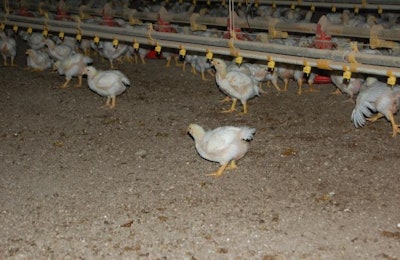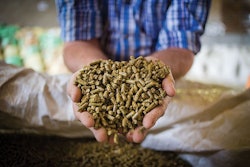
Reduction of antibiotics in poultry rearing puts greater pressure on farmers to maintain proper litter conditions in order to produce the healthiest flocks.
The biggest key for poultry farmers is keeping ammonia and litter moisture levels under control. A pair of experts on litter management, Dr. Casey Ritz, professor and extension coordinator at the University of Georgia’s Poultry Science Department, and Dr. Craig Coufal, associate professor and extension specialist in the Department of Poultry Science at Texas A&M University, explained why this aspect of litter management is critical and offered tips on maintaining proper litter conditions.
On July 12, Ritz and Coufal spoke as part of a webinar presented by WATT Global Media and sponsored by Jones-Hamilton Co. The webinar, which can be viewed on-demand, focused on "Proper litter management strategies in an antibiotic-free setting."
Avoiding ammonia
In modern broiler houses, chickens are raised on built-up litter. Managing the reuse of this substrate of bedding material is a critical part of broiler production. One major challenge of reutilization is high ammonia levels in the litter.
Ammonia at high levels can harm the health of the birds and lead to poor flock performance. Ritz said ammonia damages the cilia in the respiratory tract and reduces the chicken’s ability to remove contaminants and protect the bird from viruses and bacteria.
Using litter amendments
Litter reuse requires ammonia control through the use of litter treatments along with proper management between flocks. Among these products – including acidifiers, biological inoculants, adsorbents, neutralizers and masking agents – acidifiers are the most prominent and effective option.
Litter has a high buffering capacity, Ritz said, and applied treatments will only achieve a temporary effect. Appropriate house preparation can expand the efficacy of amendments. These include de-caking, preheating and controlling moisture content. Ritz cautioned against tilling in a product, as it will actually shorten effectiveness.
Acidifier application strategies
Acidifiers work by turning volatile ammonia into nonvolatile ammonium salt. Ritz said acid litter treatments create an acid barrier which reduces the ammonia fraction in the litter and drives more ammonia to become ammonium. The temporary acid effect reduces the amount of ammonia released.
Acidifiers will carry warning labels identifying them as anything from mildly irritant to highly corrosive. Using them requires attention to these labels and the proper precautions. Acids should be applied within the manufacturer’s use guidelines and uniformly across the house to ensure effective treatment across the house.
“The key is to apply litter treatments at an effective, recommended rate as demonstrated by the manufacturer,” Ritz said.
He warned more is not always better with acidifiers as over use creates problems. Acids should be applied corner to corner and side to side. The product should not accumulate in the corners, which makes the product available to be eaten by the birds. Timely maintenance of the watering systems helps control moisture levels and improves the efficacy of the product, too.
In antibiotic-free and extended ammonia suppression situations, sometimes acids are applied twice or more. The ideal window for the second application is 12-14 days of age when the birds will still get out of the way of the equipment.
Controlling pathogens through litter management
Reused litter should be thought of almost as a living organism with its microbiome of bacteria and microorganisms. In an antibiotic-free setting, litter management is a tool to help control pathogens, Coufaul said. Proper litter management can help reduce microbial challenges to the birds as well as reduce stress that would make birds more susceptible to pathogens.
Controlling the microbial population requires close attention to a number of factors: water, temperature, pH, nutrients and atmosphere. Farmers can control most of these variables in their litter through proper management.
Why moisture levels are crucial
The most important factor is access to water through litter moisture. Coufal said the ideal moisture level is between 20 to 25 percent. Any variability from there is related to suboptimal conditions. Excess moisture also leads to higher bacterial populations.
Controlling moisture also helps to limit microbial populations. Coufal said the best method for moisture management is removing caked litter from the house and fluffing the bed of litter. Caked litter is the wettest, and is carrying the highest microbial load, of any litter in the house.
Fluffing and de-caking can be achieved by tilling the litter. Tilling helps drying by breaking up the caked layer of litter but does carry some risk. If the bedding is overworked, this can decrease particle size. Smaller particles limit the litter’s ability to retain moisture and increases potential surface area for microbes to grow.

Windrow composting is an effective way to control pathogen levels in reused litter. | Photo courtesy Craig Coufal
Windrow composting
Composting and windrowing can help reduce the microbial load through manipulation of the bedding in between flocks. The goal is to heat the litter to kill the pathogens living therein and reduce the microbial load for the next flock.
Different machines and methods are available for this purpose. Whatever is used, Coufal stressed a few fundamentals: get the litter into a pile, allow it to aerate and rely on the good bacteria to breakdown the nutrients in the litter and the heat to kill pathogens.
The magic number in windrowing is 130. The temperature inside the windrow must reach 130° Fahrenheit to kill the pathogens. Anything lower is not as effective and only incubates microbes. Mixing and turning the material is crucial to achieving and maintaining this number. The temperature inside the pile is not equal and is highest in the center peak of the windrow.
Coufal said windrowing is helpful in pathogen destruction, redistribution of litter moisture from under the drinker lines and the drying of the pad itself. However, it can only work if the compost temperature reaches 130° F, it is given enough time to work and moisture conditions are right. At least 12 to 14 days of downtime along with appropriate moisture levels are needed for effective composting.

Litter amendments for pathogen control
Along with controlling ammonia levels, litter amendments are used to control microbial populations. Coufal said the lower the pH the better for controlling pathogens. Recent research shows the elevated acidity kills pathogens like Salmonella and E. Coli.
To achieve ammonia control, the pH level should be below seven. Killing pathogens, Coufal said, requires 4 or below. Salmonella likes to live in a slightly acidic environment like the intestinal tract of a bird, so if the litter is only slightly acidic it will help the pathogens.
Read more:
10 tips for reducing litter moisture, www.WATTAgNet.com/articles/3197


















